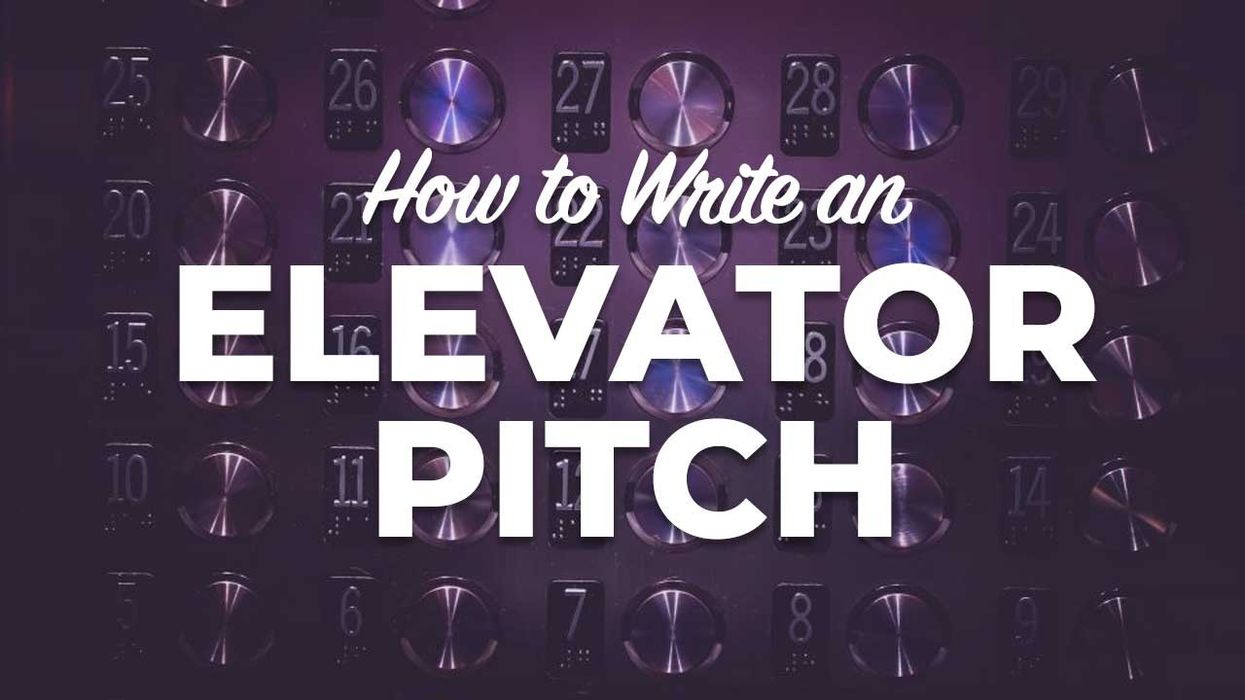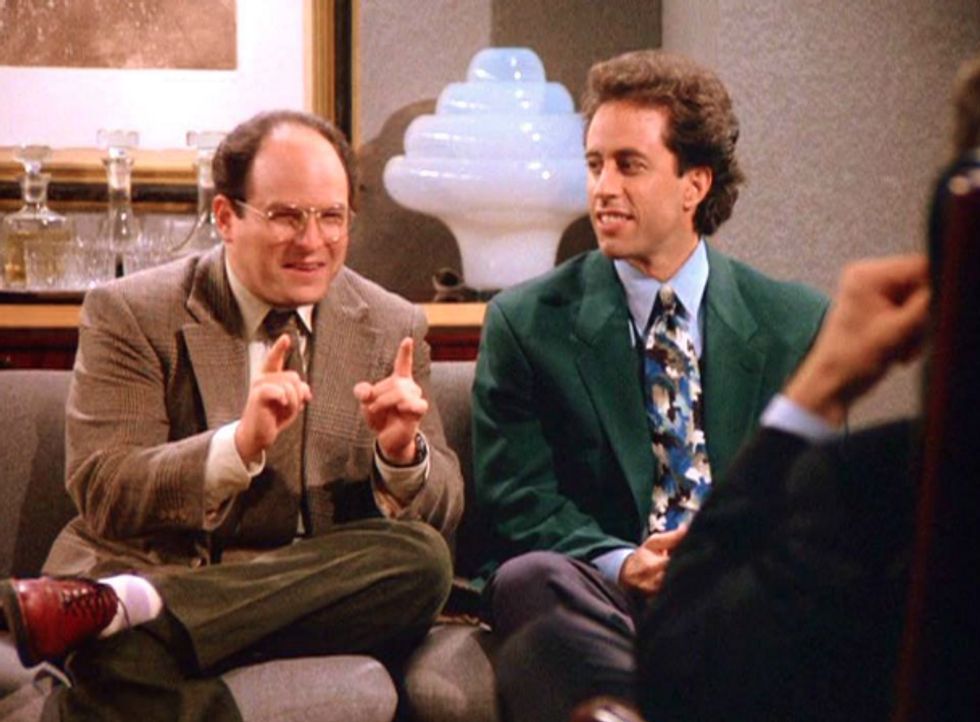How to Write An Elevator Pitch [FREE Pitch Template]
You may have a great idea but the real test is how you communicate it.

Learning how to write an elevator pitch is a skill you can’t put a price on. Why? Because we’ve all been there when lightning strikes and that excellent idea comes to life in our minds. Maybe it’s the greatest movie idea in the world. Maybe it’s an idea for a tv series or a piece of branded content.
The only way you’re going to see it through is if you can convince other people of its value. And the really hard part?
You’ll likely only ever get a few minutes to do that.
Enter the elevator pitch. The time-tested method of sharing the genius of a wonderful idea in a matter of minutes. In this post, we will break down this process plus provide you with a free elevator pitch template so you can start prepping the moment lightning next strikes.
How to Write an Elevator Pitch
The best first step when it comes to writing an elevator pitch is to get right at the core element of the concept that first grabbed you.

Your enthusiasm will be palpable in the room and on the page. What's the best way to tease out the idea?
That’s what you lead with.
We’re going to dive deeper into using the template itself and tweaking the process, but this is the critical first step. What makes you excited to sit down and write? What makes you want to see the movie? These questions are the key to your elevator pitch.
Let’s go back for a second and quickly define something…
What is an Elevator Pitch?
Yeah, we kinda skipped over that part. Why is it called an elevator pitch?
The elevator pitch is an idea is predicated on the fact that someday you could be in the elevator with someone, and you’ll only have thirty seconds to two minutes to tell them about your amazing idea.
Now, this whole scenario sounds insane, and it partially is, you’d need instant charisma with said person, and chances are if they’re in the elevator they’re probably not in the mood to work.
The model has been around for a while, and it’s helped countless creatives and people in all other businesses, formulate their ideas quickly, and present them effectively. It presents a huge challenge, and if your pitch and win in that improbable scenario, well then the sky is the limit.
Learning How to Pitch
First, you grip the ball with three fingers…Sorry, couldn’t help it.
So you want to learn how to write an elevator pitch? Well, first you need to know the basics. What’s a pitch? A pitch for a movie is a brief description of the characters, plot, and story.
You’ll do a pitch if you have a few minutes with an exec and they ask you about your next idea, you attend a pitch fest, you’re brought in by a studio or company for an open writing assignment, or you have meetings with financiers and are trying to raise money.
These are some common scenarios, but there are countless more. You want to convince your producer that this shot needs expensive camera equipment. You want to convince a star that the role you wrote her is perfect and she should take the part.
Pitching, and more importantly, learning how to write an elevator pitch, is a skill that you'll always have a use for.
The pitch should distill your idea down and make it clear to the target person what the ideas core value is. The stakes are real, so you want to get your pitch right.

How Long Is A Movie Pitch?
Pitches can range from a few minutes, to thirty seconds, to an hour. But in a professional setting for an open writing assignment or my own idea, I try to keep all my pitches between ten to fifteen minutes. You may think that seems like a long time, but there’s a lot to cover in your pitch. But, you don’t want to talk so long that people get bored.
Want to learn how to write a pitch? Watch stand-up comedy. Stand-up comedy is a lot like learning how to pitch a movie idea because they both are performative.

You’re telling a story, so you want a positive reaction. Not a yawn. The best movie pitches leave room for people to ask questions. Usually, the more questions you get, the more engaged people were during the pitch. More often than not you won’t have that much time, or you simply won't want to use up all the time with the pitch itself.
The next sections will help show you how.
Using the Elevator Pitch Skills
You can certainly pitch a movie idea within fifteen minutes, but our goal is to distill it all down into the quickest pitch possible, i.e. the elevator pitch.
Why?
Because if the quick version goes well they might want more. You start with less and tease out room for more interest.
That's better than the opposite, right?
The Elevator Pitch for Movies Ideas
In general, having your elevator pitch handy can help you in many different ways. When you move to Hollywood you’re going to take a lot of general meetings. These are sit-downs with executives and directors who WANT to hear your ideas.
I find it best to have a few of these two-minute stories laid out to keep them interested. You want them to be asking for more.
More, in this case, means reading your screenplay or treatment.
In these moments, you basically want to describe the trailer for your movie idea. The elevator pitch should be like a logline. You want to get people interested while also moving the story along.
For these, I focus on the main character, who they are, the world they inhabit, the actual inciting incident that makes the story go. Then throw in some fun scenes, the moment something truly terrible happens, how they put it back together, and finally how we leave them.
That’s a lot to do in a little time, but look at the elevator pitch I did for my movie, Shovel Buddies.
“After Sammy dies of Leukemia, his best friend Jimmy and a few of his other friends get together to clean out his room of all the stuff. What do they take? All the things you wouldn’t want your parents to find if you were dead. Booze, porn, drugs, and everything else on your cellphone. It’s the least they can do for their fallen friend. They want to destroy his cell, but instead find a random video message pleading for them to have their dead friend’s parents bury their pal in his football jersey. After the parents refuse to listen, Jimmy leads his friends across town to comply with Sammy’s wishes but wind up accidentally stealing his dead body. To make matters worse, Sammy’s police chief father is hell-bent on chasing them down. We see these kids deal with love, friendship, and a corpse as they battle with the most important lesson of growing older; loss. In the end, each kid reconciles their feelings and says goodbye. You can only carry your friend’s body around for one night. But you carry their memory forever.”
While that’s not a perfect distillation of the story, hopefully, it leaves you wanting to know more. You can clearly define the coming of age drama, see splashes of comedy, and sense the tear-jerker qualities.
When you’re prepping your movie pitch, I find it helps to write out a pitch document. Organizing your thoughts and planning ahead is all part of learning how to write an elevator pitch
A pitch document helps me follow what I need to highlight in the verbal pitch, and the double as a “leave behind.”
What’s a leave behind?
It’s a document you can literally leave behind (or have your manager forward) so the execs can revisit your pitch. Unfortunately, a lot of movie pitches nowadays are cattle-calls. There are lots of other writers you have to beat, having a document that distills your pitch can make you stand out.
Knowing how to write an elevator pitch means the document can be brief, effective, and memorable. It also will remind the execs who you are. Which helps.
Finally, it’s the least amount of free work you can engage in that still makes you come off as prepared and ready when you’re in the room.
But what should this document look like?
How To Use The Elevator Pitch Template
I structure my pitch the same way every time, and that’s why this pitch template is so useful.
First up, I like to tell people where I’m coming from on the idea. What’s my personal connection to the story, my emotional hook? As mentioned earlier, this is also connected to that core idea that grabbed you in the first place.
This is the heart of the elevator pitch, and of the project itself.
You really want to dig here. People make movies for lots of reasons, but you want them to know you’re the best person for the job because you understand the story, stakes, and characters. What in your life makes you the best person for this job.
Nobody pulls off the pitch from a personal place like Don Draper did in season one of Mad Men:
After I establish my emotional center, I hit the logline, characters, and break into all three acts, plus let them know what to expect at the very end of the movie.
Occasionally I’ll give comparable movies, or shows (called comps) to let them know what other things in the marketplace have done and why they should invest in my vision.
Be sure to grab the outline for this elevator pitch template at the end of this post.
I use this structure to get all my ideas out on the page, but when it comes time to pitch in a room, you can’t read from a piece of paper.
You have to perform.
And that can get a bit scary.
So let’s table our elevator pitch template and talk about how to behave and react in the room.
Pulling Off the Elevator Pitch
A lot of the tips in this section I took from both my own experience and from John August and Craig Mazin’s podcast called ScriptNotes.
They’re both way ahead of me in their careers, so I defer to them for strategy. But I’ve gone over their advice, and advice from some of my other mentors, and I’m going to take you through what works for me when I pitch an idea.
Let’s start at the top:
You’ve walked in the room. There’s a handful of people present. You might be drenched in sweat…But it’s okay! You’re prepared to pitch…
Before the pitch even begins, you want to build a relationship with the people in the room. This is a great time to feel everyone out and check their moods.
John August has some advice here:
“That’s why those first three or four minutes of just nonsense chit chat are actually really important for just establishing a baseline for what the room feel like. If you have to come in and like, “Okay, go. Start pitching,” you’re not going to likely have a good outcome. But if you have those little like, you know, “So what did you see?” “What are you working on?” “Oh, where did you get this trinket on your coffee table?” Those kind of things can be a huge help in getting you set or going.” ———John August, ScriptNotes, episode 55
Building this conversation relaxes everyone. If you get hired to write a script, you’re going to spend a lot of time with these people. You’re actually putting in a ton of effort to show them how fun you are to be around and how easy you are to work with when the going gets tough.
Very recently someone told me that my pitch was only okay, but they hired me because they couldn’t imagine being around the two other people they heard.
This isn’t high praise, it’s just a fact of life.
People care who they work with, so spend the time to ask them about their weekend, if they loved a recent movie, or what they’re watching on TV.
Then, find an artful way to segue those topics into the pitch.
It sounds hard, but the way to do it is to wait for them to ask you about your life or weekend.
Use your own life to then work in what drew you to the project. You want to create a personal connection to your movie pitch so they see you’re the right person for the job.
Screenwriter Craig Mazin had this to say about pitching:
“I like to introduce things by saying, “This is why I’ve always wanted to write a movie like this.” Or, “This is what I’m interested in.” I want to put the story I’m telling in the context of a personal passion, because I just think that immediately dispels [the] stink in the room. And the stink is cynicism, because when somebody’s coming into pitch, they’re there to sell you something. They’re knocking on your door with a vacuum cleaner set and they want to sell you something. And everybody knows it and it’s a little bit cynical. And I like to kind of broom that stink out by saying, “Yes, sure, I’m here to sell you vacuum, but actually this is emotional for me, and here’s why.” Even for a comedy. There’s something at the core of it that matters to me.” ———Craig Mazin, ScriptNotes, episode 55
Craig makes an excellent point. The only way to stand out in these rooms is to show why you HAVE TO be the person to write this idea. You want to stick out on producers minds. Make sure your personal section also reflects the genre of the project you’re pitching.
Don’t tell a traumatic story for a comedy, don’t lead in with a bunch of jokes if you’re working on a drama.
This is the time to read the room.
Don’t know what that means? Go back up and read the John August quote. Or keep reading because I’m going to explain it now.
You can’t learn how to write an elevator pitch and pull it off in the room without learning to read other people’s moods. Reading the room is when you try to suss out the mood of everyone participating in the meeting. Sometimes producers and execs will be in a bad mood. That’s not your fault, but you have to learn how to roll with it.
I make sure to listen as much as I speak when I deliver my personal anecdote.
There’s a good chance they’ll hear 20 pitches. Yours will stand out if you can read the room, and connect your personal story to something that matters to them.
Or you can make them laugh really hard.
Once I have the personal connection out of the way, I transition into how I came up with the idea at hand. What sparked this particular idea? If I’m pitching on someone else’s project, I modify that a bit. I try to show how my life similarly butts up against the story in front of me, and how that fact drew me into the plot, and how I want to put my twist on the great parts that have already been presented.
Next, I give them a brief logline. I want that logline to tell us the genre, the stakes, and get the protagonist and antagonists out of the way.
One I set the scene with the logline, I break down the characters. Who are we following and why? What’s the arc we’ll see over the course of the movie?
Who are these people when we meet them? What happens in Act One that thrusts us into the rest of the story?
When you get into the meat of Act One, Act Two, and Act Three, I like to employ the trailer strategy.
I visualize the trailer for the movie I’m describing. The typical movie trailer is around two minutes and thirty seconds long. I expand each part and ease everyone into the story.
- Act One is about meeting the characters and seeing where they are in life.
- Act Two is about describing how things start to change and getting a highlight reel of the set pieces we’re going to encounter.
- What are the hurdles in this story?
- What are the moments people will talk about in the lobby?
- And then I hit them with the gut punch.
I tell them how things begin to go wrong in Act Two. I list all our characters’ failings. And I crush them with how bad things get for the characters.
Then you bring it home with Act Three. Talk about how things come back together, how the characters push on, and things begin to come back together. Then I focus on the last set piece, the one that would be the most fun, or emotional, or both.
Finally, I tell them where we leave the characters. Is it a mic drop? Left open for a sequel? A twist ending? Hit them in the feels again and make them excited to tell their friends about the movie.
If this is an original idea, I also like to do a little research about the marketplace. What are some successful movies that your idea compares to? When I say successful, I mean monetarily AND critically.
That’s how to pitch a film. But the basic skills apply to any pitch.
One mistake I made early on was pitching ideas and not thinking about other similar successful projects. It was a mistake because in Hollywood, money matters.
So pick successful films within the same genre. The ones that EVERYONE sees.
So now that you get the idea of how to pitch… where are you going to do it?
Where To Pitch A Movie
Movie pitches come in all shapes and sizes. You could be talking to some indie producers or the president of Disney. It depends on the idea, the people behind it, and where you are in your career. Many A-list screenwriters don’t go out for smaller jobs. That’s good news for you, but you’ll still have to excel past a sea of other writers trying to get an assignment in the industry.
Most commonly, pitches are for open writing assignments or OWAs.
OWAs are often projects at production companies or studios that have been in development for a while. People are always looking for a fresh new voice to come in and take on revamping interest in articles, scripts, or books. They also frequently acquire other property such as games, movie remakes, and even toys that need stories to be written.
You may also have a package you’re taking out as a pitch. A package is when a few different people get together to try to sell an idea to studios or producers. You may have a director, writer, and actors pushing a story they want to bring to the silver screen. This package will go studio to studio, pitching execs on what makes their idea and team special.
Maybe you’ll get lucky and share an elevator ride with a huge Hollywood power-player some day. If you have the guts, and they ask, have your thirty-second elevator pitch ready.
You never know what can happen if you pique someone’s interest.
You may also need to perfect your pitch for a pitchfest. Pitchfests, like this one, are contests where writers basically do a “round robin” with prospective agents, managers, and producers. They pitch their ideas in a few minutes, to see if they can garner interest.
I have never found pitchfests to be effective or worth your time or money. But maybe you disagree.
Regardless, you’re going to need a taunt and exciting pitch for all of these situations.
No matter why you’re pitching, or where you pitch your movie, you’re going to need to learn how to write a pitch first.
Congratulations, you’ve scored the opportunity to test whether or not you’ve learned how to pitch a movie idea. Now you have to prepare.
Learning how to write an elevator pitch is crucial to this business. It’s a different muscle than writing a screenplay, so it doesn’t come naturally to everyone. Trust me, I had to learn all this stuff the hard way. The business of screenwriting is so much more than just coming up with stories.
When I was starting out, I bombed dozens of movie pitches. But it was a blessing in disguise.
It forced me to focus on describing a beat sheet for the movie. My pitches would run long, and I spent way too much time on the minutia, instead of highlighting what made the movie interesting.
Summing Up The Elevator Pitch
So you’ve learned how to write an elevator pitch, how to build it out into a much bigger pitch, and hopefully get your best and most important ideas onto the page. Who’s ready to take their pitch out on the town?
I know there was a lot here, but effective pitching winds up being important when you want to break into the industry. And even more than that it’s a skill you can use every day, all the time.
Learning how to pitch a film isn’t about filling in the blanks, it’s about executing in the room.
Grab your spouse, or roommate, or dog, and try out your movie pitch on them. Not great at pitching yet? Keep learning how to execute the elevator pitch over time by pitching over and over again.
So copy and paste our elevator pitch template. If it works for you, let us know in the comments. If you have ideas for how to improve it, let us know those too!
I’m excited to see what you write next.
- How to Make a Lookbook for Your Film or TV Project (with Examples) ›
- How to Pitch Your Film: A Step-By-Step Breakdown ›
- What's a One-Sheet (and Why Do Producers Want It?) ›

















